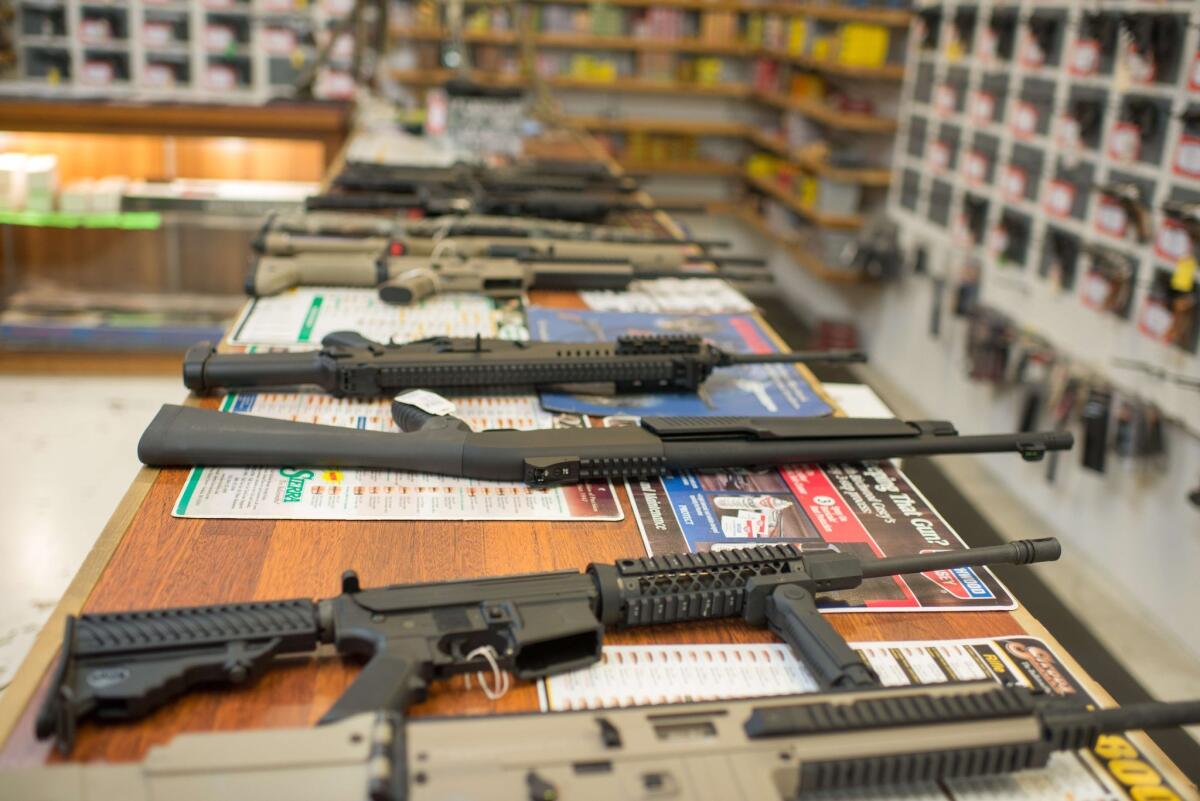Op-Ed: Guns in the U.S.: We’re better at killing Americans than our enemies are

Guns are on display at Roseburg Gun Shop in Roseburg, Ore., on Oct. 2.
If your gut tells you that mass public shootings are alarmingly common, your gut’s right.
The Federal Bureau of Investigation defines a mass murder as four or more deaths during a single incident with no distinct time period between killings. By this definition, according to Northeastern University criminologist James Alan Fox, between 1980 and 2010 there were an average of 20 mass murders per year, or an average of one every 2.6 weeks.
Now it looks like that interval is shrinking. According to shootingtracker.com, there were 30 mass public shootings with four or more dead in 2014, and there have been 31 this year through the Oct. 1 tragedy in Roseburg, Ore., or one every 1.6 weeks.
No wonder President Obama feels like he’s repeating himself with sullen regularity in his post-shooting speeches.
Our gun problem of course extends beyond mass violence. In 2014 alone, for example, the Centers for Disease Control and Prevention recorded 11,208 people shot to death, 33,636 injured by gunfire and 21,175 who killed themselves with a gun. That’s a total of 66,019 people who were killed or injured by a gun, which comes out to 1,269 per week, 180 a day or 7.5 per hour.
Add up all the gun fatalities since 1970 (approximate annual average of 30,000, according to the CDC) and you get the staggering figure of 1.35 million dead, which is disturbingly close to the figure of 1.39 million Americans who have died in all wars since the American Revolution.
Perhaps this is the gruesome price of freedom. The 2nd Amendment guarantees us the right to own a gun, and the U.S. Supreme Court has upheld that right in two recent cases. But should you, dear reader, choose to own a gun?
Consider this finding from a 1998 study published in the Journal of Trauma and Acute Care Surgery: “Every time a gun in the home was used in a self-defense or legally justifiable shooting, there were four unintentional shootings, seven criminal assaults or homicides, and 11 attempted or completed suicides.”
In other words, the fantasy many of us have of facing down an intruder with a firearm is belied by the fact that a gun is 22 times more likely to be used in a criminal assault, an accidental death or injury, a suicide attempt or a homicide than it is for self-defense.
If you own a gun and keep it safely locked up and unloaded with the ammunition somewhere else (recommended by gun safety experts), do you really think that, in the event of a break-in, you could get to your gun, find your ammo and load it, engage the intruder, accurately aim and kill him, all before he takes your things? If you do, you’ve been watching too many movies. Go to a firing range and try shooting a handgun. It isn’t easy to do. It requires regular training.
If you own a gun and you don’t keep it safely locked up — if you keep it loaded and under your pillow, say — you might have a chance against an intruder, but you’re also setting yourself up for an accident. A depressed relative or perhaps a child could find the gun.
A 2009 study corroborated these findings. Conducted by epidemiologists at the University of Pennsylvania School of Medicine and published in the American Journal of Public Health, it found that, on average, people with a gun are 4.5 times more likely to be shot in an assault than those not possessing a gun.
But let’s go back to your gut for a second. What if you acknowledge the validity of the statistics above, but your intuition tells you that gun control laws just won’t work to reduce the carnage. Is your gut right? No, it’s almost certainly not.
For a 2013 study published in the Journal of the American Medical Assn. Internal Medicine, researchers mined a database of 121,084 firearm deaths between 2007 and 2010. Then they compiled a “legislative strength score” for all 50 states based on the number and force of their gun control laws, and divided the states into quartiles. As it turns out, the states in the highest quartile of legislative strength had the lowest overall firearm fatality rate, and those in the lowest quartile had the highest fatality rate. This correlation held for both homicides and suicides.
The authors were careful to note that correlation does not imply causation. But earlier studies have also found that the higher a state’s gun ownership rate, the higher its rate of gun-related homicides and suicides. Yes, people can kill one another and themselves with knives, ropes, lead pipes, wrenches and candlestick holders, but the data match the growing national intuition that guns are a major problem.
Michael Shermer is the publisher of Skeptic magazine, a monthly columnist for Scientific American, a presidential fellow at Chapman University and the author of “The Moral Arc: How Science Leads Humanity Toward Truth, Justice, and Freedom.”
Follow the Opinion section on Twitter @latimesopinion and Facebook
More to Read
A cure for the common opinion
Get thought-provoking perspectives with our weekly newsletter.
You may occasionally receive promotional content from the Los Angeles Times.






